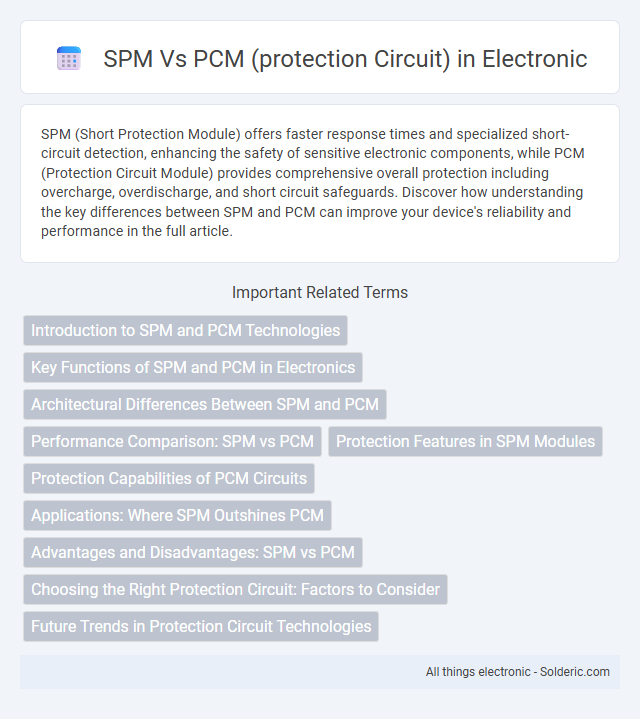SPM (Short Protection Module) offers faster response times and specialized short-circuit detection, enhancing the safety of sensitive electronic components, while PCM (Protection Circuit Module) provides comprehensive overall protection including overcharge, overdischarge, and short circuit safeguards. Discover how understanding the key differences between SPM and PCM can improve your device's reliability and performance in the full article.
Comparison Table
| Feature | SPM (Smart Power Module) | PCM (Protection Circuit Module) |
|---|---|---|
| Primary Function | Integrated power device with built-in protection | Dedicated circuit for protection and fault isolation |
| Protection Types | Overcurrent, overtemperature, undervoltage | Overcurrent, short-circuit, thermal shutdown |
| Integration Level | High - power devices plus control and protection | Moderate - external protection added to circuits |
| Application | Motor drives, power inverters, industrial automation | Battery packs, power supply units, electronic modules |
| Complexity | Complex, multifunctional unit | Simple to moderate, focused on protection |
| Typical Components | IGBT/MOSFETs, sensors, control ICs | Fuses, PTC thermistors, voltage/current sensors |
| Cost | Higher - due to integration and features | Lower - basic protection function |
| Reliability | High - designed for robust protection | Depends on design and components |
Introduction to SPM and PCM Technologies
SPM (Smart Power Module) and PCM (Protection Circuit Module) are advanced electronic modules designed to enhance the reliability and safety of power semiconductor devices. SPM integrates power transistors and built-in control or protection functions, optimizing thermal management and switching performance in applications like motor drives and power supplies. PCM focuses primarily on safeguarding lithium-ion batteries by monitoring voltage, current, and temperature to prevent overcharge, over-discharge, and short circuits, ensuring battery longevity and safety.
Key Functions of SPM and PCM in Electronics
SPM (Smart Power Module) integrates power devices with built-in protection features such as overcurrent, overtemperature, and short-circuit prevention, ensuring efficient and reliable operation in motor drive and power conversion applications. PCM (Protection Circuit Module) primarily safeguards batteries by monitoring voltage, current, and temperature to prevent overcharging, overdischarging, and short circuits, extending battery life and enhancing safety. Both SPM and PCM optimize system reliability by providing precise control and protection tailored to their specific electronic component roles.
Architectural Differences Between SPM and PCM
SPM (Smart Power Module) integrates power devices with built-in protection features like overcurrent and thermal shutdown, offering compact architecture and easier system design. PCM (Protection Circuit Module) functions primarily as a standalone protective unit, often using discrete components to safeguard batteries or circuits against overcharge, overdischarge, and short circuits. Your choice between SPM and PCM depends on whether you need integrated power management or a dedicated protection solution tailored for battery safety.
Performance Comparison: SPM vs PCM
SPM (Silicon Protected Module) offers enhanced thermal stability and faster response times compared to PCM (Phase Change Material) protection circuits, enabling more reliable overcurrent and short-circuit protection. PCM circuits provide efficient energy absorption and insulation but typically exhibit slower reaction speeds under transient fault conditions. The choice between SPM and PCM depends on specific application requirements, with SPM favored in high-performance electronics demanding rapid fault mitigation and PCM suited for thermal management in moderate protection scenarios.
Protection Features in SPM Modules
SPM (Smart Power Module) protection features include integrated short-circuit detection, overcurrent protection, and thermal shutdown mechanisms that enhance device reliability by preventing damage during fault conditions. These modules incorporate advanced diagnostic feedback for real-time monitoring and fault reporting, ensuring precise control and system safety. Compared to traditional PCM (Protection Circuit Module), SPM modules offer more compact and efficient integration of power stages with comprehensive protection functions.
Protection Capabilities of PCM Circuits
PCM (Protection Circuit Modules) excel in safeguarding batteries by providing overcharge, over-discharge, overcurrent, and short-circuit protection with precise voltage and current control. These circuits ensure battery longevity and safety by actively monitoring and responding to electrical anomalies, preventing damage during operation. You can rely on PCM circuits for comprehensive, reliable protection in various battery-powered applications.
Applications: Where SPM Outshines PCM
SPM (Smart Power Module) excels in high-performance motor control applications, such as industrial automation and electric vehicles, where integrated protection and compact design are critical. Its advanced thermal management and fault detection capabilities outperform PCM (Protection Circuit Module) in scenarios demanding precise and reliable power handling. Your system benefits from SPM's ability to deliver efficient performance with enhanced safety in complex, high-current environments.
Advantages and Disadvantages: SPM vs PCM
SPM (Switching Power Module) offers high efficiency and compact design, making it ideal for applications requiring precise power control, but it can be more complex and costly compared to PCM (Protection Circuit Module). PCM provides effective overcharge, over-discharge, and short circuit protection, enhancing battery safety with simpler design and lower cost, although it lacks the advanced power management capabilities of SPM. Your choice depends on whether you prioritize advanced power efficiency and control (SPM) or straightforward, reliable protection with cost efficiency (PCM).
Choosing the Right Protection Circuit: Factors to Consider
When choosing between SPM (Surge Protection Module) and PCM (Protection Circuit Module), consider the specific application requirements such as voltage rating, response time, and current capacity to ensure optimal device safety. Evaluate the environmental conditions, including temperature range and potential transient events, to select a protection circuit that offers reliable performance and durability. Prioritize compatibility with system components and ease of integration to maintain overall circuit efficiency and minimize downtime.
Future Trends in Protection Circuit Technologies
Emerging protection circuit technologies emphasize the integration of Silicon Power Modules (SPM) with enhanced pulse current capabilities and Pulse-Conditioned Modules (PCM) designed for faster fault detection and isolation. Future trends include the adoption of wide bandgap semiconductors like SiC and GaN to improve thermal management and switching speeds in both SPM and PCM configurations, enabling higher efficiency and reliability. Advanced machine learning algorithms are increasingly embedded in protection circuits to predict failures and optimize response times, reducing downtime and maintenance costs across power electronic systems.
SPM vs PCM (protection circuit) Infographic

 solderic.com
solderic.com